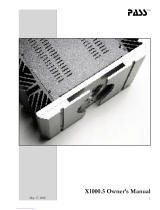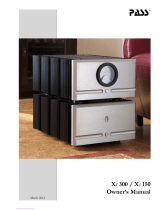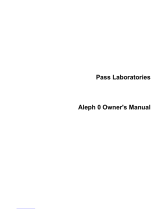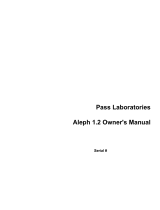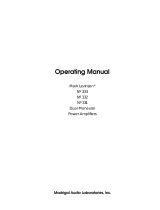Page is loading ...

1
X250.5 Owners Manual
pass
TM
X250.5 Owner’s Manual
May 17, 2006

2
X250.5 Owners Manual
The Pass Laboratories ™ X250.5 stereo amplifier embodies the de-
sign technolog y and refinements of the “X” series amplifiers includ-
ing extensions of the patented Supersymmetry™ circuit. Additionally
selected refinements of the XA series amplifiers have been incorpo-
rated into the X250.5 to significantly improve this products sonic
perfor mance in comparison to it’s immediate predecessor, the Pass
Laboratories™ X250.
The Supersymmetr y™ circuit topolog y was g ranted a U.S. patent in
1994, and was the result of 19 years of effor t by legendar y analog
designer and company founder Nelson Pass. T he amplifier uses
highly matched components in a classically simple single ended Class
A circuit. T he amplifier contains only two simple stages: the first is a
balanced Class A g ain stag e. Its output drives a bank of high power
devices operated as followers.
These are inherently low distor tion types of circuits, but their perfor-
mance is significantly improved when operated as balanced devices.
Distortion and noise identical to both halves of a balanced circuit can
be made to disappear at the output, and in a well-matched symmetric
circuit, most of the distortion and noise is identical.
Pass Laboratories Supersymmetr y™ enhances this effect by provid-
ing a connection between the two halves of the balanced circuit that
further perfects the match of common mode artifacts. Any distor-
tion and noise not already identical to the two halves is made more
identical by a factor of about 10. T he result of this perfected match
is improved noise cancellation at the output of the amplifier. From a
listeners standpoint this results in a more accurate presentation of the
soundstage and better resolution of low level detail.
Unlike feedback techniques where the g oal is to cor rect for the distor-
tion by feeding a gain stage an inversely distorted signal, Supersymme-
tr y™ seeks merely to create perfect matching between the two halves
of an otherwise well matched circuit.
Matched balanced power circuitr y typically sees a distortion and noise
reduction of about 90% (20 dB) through a balanced connection
without any additional effort. T he Supersymmetr y™ circuit delivers
another 90% reduction, so that the X series has about 1/100 of the
distortion of a conventionally simple and otherwise identical ampli-
fier. Distortion and noise can still be seen at the output of one half of
the circuit, but since it is virtually identical on the other half, these un-
desirable ar tifacts larg ely g o away at the speaker ter minals. T his gives
g ood measured perfor mance, and because a simple circuit produces it,
also sounds quiet excellent.
Introduction

3
X250.5 Owners Manual
Previously these kinds of simple Class A circuits have been popular
for their sound quality in low power amplifiers, but have not found
application at high power levels due to excessive distortion and low
efficiency. Supersymmetr y™ overcomes this bar rier, delivering the
sweetness, staging, and detail of very simple circuitr y up to kilowatt
power levels and beyond.
The X.5 Series amplifiers have the tremendous dynamic rang e (>140
dB) to do justice to the high-resolution digital recordings of the 21st
Centur y and the eleg ance to retrieve the micro dynamics offered by
the most sensitive loudspeakers. The simple but powerful circuitr y
moves easily from total silence to explosive transient and back to
silence without a trace and without infor mation loss. Ver y unlike
conventional high power amplifiers, they provide this level of power
with a subtlety befitting some of the better tube amplifiers. This per-
for mance is consistence across the audio spectr um and the amplifiers
are unconditionally stable into all speaker loads.
So relax and enjoy your amplifier. Call us if you ever have a problem
or question. You are welcome to ask questions or offer comments.
Thank you for buying our product.

4
X250.5 Owners Manual
You can position this amplifier most anywhere you wish, but it re-
quires adequate ventilation. We do not recommend placing it in
enclosed cabinets or small closets without means for air to circulate
freely. Stacking these power amplifiers directly upon each other is not
recommended for the same reason. T his amplifier typically idles at
slightly less than 350 watts, most of which dissipates as heat across
the heatsinks. As a point of reference, these heatsinks should never
become too hot to touch for several seconds.
Let’s talk about AC power requirements. This amplifier draws about
3 amps (continuous r ms) at 120 volts out of the wall during nor mal
operation, and this power draw ref lects mostly the idle cur rent that
we r un through the output stag e. If you are driving a low impedance
load, you will draw more power than this, but this will not be typical.
The amplifier’s voltage and cur rent rating are indicated on the rear
panel. It will be 240 volts, 220 volts, 120 volts or 100 volts, all with
an appropriate rear mounted resetable circuit breaker. T he frequency
rating of the AC line source in all instances will be 50 to 60 Hz. Please
verify that the amplifiers indicated voltage requirements are consistent
with the line voltag e supplied at your location.
The Pass Laboratories™ X250.5 is provided with a conventional IEC
detachable AC line cord, which is rated at 15 amps. The safety ground
is attached to the chassis in the conventional approved manner. T he
AC power input to the amplifier r uns through a RF filter, which re-
moves high frequency noise coming into and g oing out of the ampli-
fier power supply.
Under no circumstances should you defeat the g round connection of
the power cord. For your safety, the chassis of the amplifier should be
earth g rounded. Signal g round is isolated from chassis, safety ground,
to reduce the incidence of g round loop noise. T he presence of a
safety g round will not deg rade the audio signal chain.
You may substitute an after market detachable IEC 320 style power cord
of your choosing; provided it is rated for at least 15 amps and it meets all
leg al requirements and has been approved by the local testing authority
for such things.
Looking at the rear panel you will see the IEC 320 AC power cord
receptacle, a ther mal magnetic breaker switch, two pairs of output con-
nectors, a pair of binding post connectors for remote turn-on, one RCA
input connector and one XLR balanced input connector.
Make sure that the breaker switch is off (down). Plug the AC cord into
Setup

5
X250.5 Owners Manual
the back of the amplifier, and then into the wall. Then turn the breaker
switch on (up). The lights in your house will blink when the power sup-
ply charges the capacitors; this is nor mal. This magnetic breaker switch
is not to be used as a safety disconnect during ser vicing and is not a
substitute for unplugging the power cord.
On the front panel, the “Standby” LED indicator should be glowing
blue, indicating that the power is on. The “Power” LED should not be
on. If the “Power” LED is on, don’t g et excited, just use the front panel
stand-by button to go into stand-by mode, with the “Standby” LED on
and the “Power “ LED off.
OK, so the amplifier is sitting there in stand-by mode with just the single
blue LED lit. No speaker connected, as yet. You can go ahead and con-
nect the source and speakers. Some speaker cables are ver y difficult to
work with due to physical size and construction, make sure the speaker
connections do not short together. It is recommended that you connect
the speaker ends of these cables first.
Some powered subwoofers require an audio signal ground reference and
their makers may sug gest that a black speaker ter minal is where this volt-
age reference might be found. On complementar y designs, which would
be typical of all power amps produced by Pass Laboratories™, this is
an incorrect and unsafe assumption. On all Pass Laboratories™ power
amplifiers a reference of 0 volts will be found only at pin 1 of the XLR
input or at the shell of the RCA input.
Reference connections for these devices require special consideration
when used with our product. If you have such a device, and wish to
use it with our product, please contact our Foresthill, California fac-
tor y for specific instr uctions.... you have been warned.
The amplifier can be driven single-end or balanced, if driving the am-
plifier single-ended, leave the supplied jumper in place (between pins
1 & 3 on the XLR). Your amplifier will operate without the jumper
in place, but perfor mance will be significantly diminished. You must
choose either XLR or RCA inputs it is not advised to try and r un both
concur rently.
Now that the source component is connected, make sure there is no
signal coming from it, probably by turning the volume all the way
down.
With the speakers connected, push the front panel button to activate
the amplifier. The “Power” LED will come on.

6
X250.5 Owners Manual
Do ever ybody a favor and try not to have shorted output cables. It
happens accidentally all the time, and the amplifier is designed to sur-
vive, mostly.
Of course it’s always possible that something could g o wrong. If so,
don’t g et excited, just relax. It’s really ag g ravating when something like
this doesn’t work, we understand, but it will g et fixed. We g o to a lot
of trouble to make products reliable, and the failure rate of our ampli-
fiers is very low. This is small comfor t to the few, but take it easy and
give us a call if you have problems.
People are often interested in how long it takes for these amplifiers
to break in. Perhaps a more salient question is how long does it take
them to reach their sonic best after tur n on. It takes about an hour for
them to fully war m up, and this is where we adjust them first. T hen
we adjust them ag ain and again over a couple of days, keeping the bias
and offset in the sweet spot. Our environment is about 23 degrees
Centig rade and the heat sinks will rise approximately 25 deg rees C.
above that, for an average on heat sink temperature of 48 deg rees C.
Sonically they are at their best when the heatsinks are approximately
50 deg rees C.
In your setup the temperature may var y a bit due to line voltage varia-
tions and ventilation, but this is not a big deal. You should be able to
put your hands on the heat sinks without discomfor t for 10 seconds
or so. It is nor mal for the heasink temperature to var y side-to-side and
front to back.
The amplifier has a ther mal cutout that will disconnect AC power if
the temperature exceeds 75 deg rees Centig rade. This should never
occur in real life.
More things to know
You can remotely operate the stand-by mode by applying 12 volts DC
to the single pair of binding post connectors on the rear of the ampli-
fier. The positive of the 12 volts DC goes to the red connector. This
connection has an actual operating range of about 9 volts to 15 volts
at a cur rent draw of approximately 5.0mA. T his switching will over-
ride the front panel button, so if you want the front panel button to
operate, leave the rear connection open.
So much for the most essential information.
You are ready to play music

7
X250.5 Owners Manual
The Pass Laboratories™ X250.5 is optimized for loads nominally rated
at 4 ohms and above. You can r un the amplifiers into a lower nominal
impedance without difficulty, and we are not aware of a speaker on the
market that presents unusual difficulty with these amplifiers.
The X.5 series amplifiers do not care par ticularly about the reactivity
of the load. Reactive loads typically will have slightly less distor tion
at a given voltage/cur rent level than resistive loads, but will make the
amplifier r un a little hotter. T he X.5 circuit was designed to be quite
happy driving electrostatic and other difficult speakers.
When driving transfor mer-coupled loads directly, as in some elec-
trostatic and ribbon designs, some attention must be paid to the DC
character of the situation. If the transfor mer primar y is being driven
raw with no protection from DC and your source has DC voltage, or
in cases where the small offset of the power amplifier is still too much,
you may create distor tion in the transfor mer and get less than optimal
perfor mance from it. Generally this is not the case with transfor mer-
coupled loudspeakers, but it does occasionally surface. In these cases,
take special care that the source does not contain a differential DC
component, and confir m the differential DC offset of the pre-ampli-
fier is sufficiently low. T his differential voltage is easily adjusted by a
qualified technician ar med with the appropriate ser vice documents.
We have a general recommendation about interconnects, which is that
they should cost less than the amplifier, and be f lexible enough to work
with. We have tried a lot of products and most of them work well, but
as a practical matter we cannot make blanket recommendations.
The amplifier is not sensitive to source interconnects or g round loops.
It is also not sensitive to radio frequency pickup, which allows some
flexibility in choosing source interconnects without shields, though
shields are always in g ood taste.
We prefer speaker cables that are thick and shor t. Silver and copper
are the prefer red metals. If you find any cable made of g old, please
gift us a couple hundred meters.
Fortunately the amplifier is not sensitive to the capacitive/inductive
character of some of the specialty speaker cables, so feel free to ex-
periment.
We have found that about 90 per cent of bad sounding cables are in
reality bad sounding connections, and we recommend that special at-
Speaker Interface
Interconnects and Speaker
Cables

8
X250.5 Owners Manual
tention be paid to cleanliness of contact surfaces and proper fit.
Speaker cables should be fir mly tightened down at the speaker output
ter minals, but do not use a wrench. T hese connectors will not with-
stand unrealistic foot-lbs of torque. Hand tightening without exces-
sive force is plenty.
Hardware Facts
So how long will this hardware last? It is our experience that, bar ring
abuse or the odd failure of a component, the first things to go will be
the power supply capacitors, and from experience, they will last 15 to
20 years before needing replacement. For tunately these components
die g racefully; typically with years of warning and are easily re placed.
After that, the long evity will de pend on the number of operating ther-
mal cycles, but we can attest to having had amplifiers operating in the
field in excess of 20 years with no par ticular mor tality except capaci-
tors. We don’t have g ood infor mation beyond that. More to the point,
we would sug gest that you not worr y about it. T his is a conser vatively
built industrial design, not a tweaky tube circuit r un on the brink of
failure. If it breaks, we will simply get it fixed, so sleep well.

9
X250.5 Owners Manual
All figures obtained after a 1 hour war mup, with regulated 120 VAC
power line. See manual notes about AC power line regulation.
Gain 30 dB
Freq. Response -3 dB at 1Hz, -3 dB at 100 kHz
Power Output 250 watts @ 1% THD, 1 kHz, 8 ohms
Maximum Output Voltag e plus, minus 60 volts
Maximum Output Current plus, minus 20 amps
Input Impedance 22 kohm balanced,
12 kohm single-ended
Damping factor 250 ref 8 ohms nominal
Slew rate plus, minus 50 V/uS
Output Noise 400 uV unweighted 20-20 kHz
Balanced CMRR -60 dB @ 1 kHz (input common
mode rejection ratio)
DC offset < 100 mV differential
Power Consumption 350 watts idle, 1000 watts max.
Temperature 25 degrees C. above ambient at idle.
Dimensions 19”W x 22”D x 9.5”H
Weight 110 Lbs.
For more infor mation please contact:
Pass Laboratories Inc.
P.O. Box 219,
24449 Foresthill Rd.,
Foresthill, CA 95631
Tel: 530.367.3690
Fax: 530.369.2193
www.passlabs.com
© 2006, Pass Laboratories Inc.
X250.5 Specifications
“Pass”, “pass”, “Pass Labs”, “Pass Laboratories”, Supersymmeter y”,
“Ale ph”, and “Zen” and are all registered trademarks of Pass
Laboratories, Inc., and all rights thereto are protected by law.

10
X250.5 Owners Manual
Please check with the factory-authorized distributor in the country you are
purchasing this product for specific war ranty infor mation.
All Pass Laboratories products purchased from an authorized Pass Labora-
tories dealer in Nor th America are covered by a transferable, limited 3-year
warranty. This war rantee includes all parts and labor charges incur red at the
repair facility in addition to return shipping to the domestic customer, exclu-
sive of subsequent damag es. Damage due to physical abuse is specifically
not covered under this warranty.
For this war ranty to apply the customer is responsible for retur ning the
product unmodified to the factor y within the warranty period. T he customer
assumes all responsibility for shipping and insurance to the factor y or a fac-
tor y specified repair facility. T he conditions and stipulations of this Pass
Laboratories warranty only applies to units sold new in Nor th America.
Non-North America customers should consult with their original Pass Labs
dealer or distributor for war rantee repair instr uction prior to contacting the
factor y or shipping product for repair.
Non-North American product must be returned to the country of origin for
warrantee service. Foreign distributors are only required to offer war ranty
ser vice on Pass Laboratories product that they have imported.
Please note: Conditions of war ranty ser vice and customer rights for product
purchased outside the United States may var y depending upon the distribu-
tor and local laws. Please check with your local distributor for specific rights
and details.
Any modifications to Pass Laboratories products that have not received
written factor y approval nullify all claims and void the warrantee. Should a
modified product be retur ned to the factor y for repair the owner will be re-
quired to pay all necessary charges for the re pair in addition to those charg es
required to return the product to it’s original configuration.
In the case of safety issues, no product shall be retur ned to the customer
without those safety issues being cor rected to the most recent accepted
standards.
Removal or alteration of original Pass Labs serial numbers voids the factory
warranty. Product with altered or missing serial numbers will be suspected
as counterfeit product.
Pass Laboratories will not repair or in any way indemnify any counterfeit or
cloned product.
Pass Laboratories does not offer products in voltages intended for inter-
national markets either to authorized Pass Labs dealers or to third par ties
located in the United States or Canada.
Warranty Information

11
X250.5 Owners Manual
Water and moisture: Electrical devices should not be used near
water ( as per example, near a bathtub, washbasin, kitchen sink,
laundr y tub, wet basement or swimming pool ). Care should be
taken such that objects do not have the oppor tunity to fall, and that
liquid is never spilled onto or into the device enclosure through
openings.
Power Sources: An electrical device must be connected to a mains
power source in strict accordance with the supplied product owner’s
manual. Please verify that the AC mains voltage specified in the
product manual matches those requirements indicated on the unit
and the AC voltage provided to your location by the power company.
Grounding: Adequate precautions should be taken so that the
g rounding provisions built into an electrical product are never
defeated.
Power Cords: Pass Laboratories provides a power supply cord that
meets all legislated requirements for the market in which the product
was originally sold. If you choose to substitute an after-market
product we urge you to choose one that is fully safety rated by the
necessar y local authority.
Power Cord Protection: Power supply cords should be routed so
that they are not likely to be walked on, abraded, or pinched by items
placed on or ag ainst them, paying particular attention to cords where
they enter plugs or exit from a device. Never under any circumstance
insert a cut or damag ed power cord into a mains power socket.
Power and Signal: Cables should never be connected /
disconnected with equipment powered up. Failure to heed this
warning may damage or destroy equipment.
Ventilation: Power-amplifiers r un hot, but you should be able to
place your hands on them without discomfort. You must allow for
this heat in installation, by providing for free air circulation around
the product. Electronics should not be subjected to sources of
excessive radiant heat. Excessive heat can shorten the life of the
product and may cause the electronics to self-protect and shut down.
Servicing: To reduce the risk of fire, electrical shock or other
injuries, the user should not attempt to ser vice the device beyond
that which is described in the operating instructions. All other
ser vicing must be refer red to qualified ser vice personnel.
For your protection please
read the following:
/










